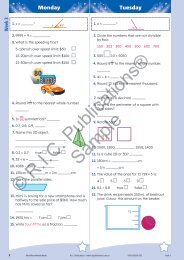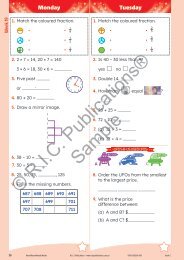PR-6171IRE Science A STEM Approach - 1st Class
You also want an ePaper? Increase the reach of your titles
YUMPU automatically turns print PDFs into web optimized ePapers that Google loves.
Energy and Forces<br />
NOW YOU SEE IT! NOW YOU HEAR IT!<br />
Lesson 1<br />
Lesson Plan<br />
Note: This lesson is to establish pupils’ prior knowledge about light and sound.<br />
Introduction:<br />
1. Block out as much light as possible and turn off all the lights. Alternatively, take the pupils into a<br />
dark room such as a storeroom. What can you see? What can you hear? Pupils may respond with<br />
ideas such as ‘nothing’, ‘shadows’ or ‘breathing sounds’. Switch on a large torch and point it to<br />
a number of different objects in the room. What can you see now? How did you see the objects<br />
pointed to? Turn the lights back on. When we see objects, what part of the body is being used?<br />
When we hear things what part of the body is being used?<br />
Development:<br />
2. As a class, brainstorm what pupils know about sound and light and share examples from their<br />
everyday life.<br />
3. In small groups, pupils rotate through six stations, each with a large piece of paper with one of the<br />
questions from page 60 glued to it. (One question per paper. More stations may need to be set up<br />
depending on class size). Pupils draw or write answers to the question using an allocated marker<br />
pen colour, before rotating to the next question. They will need to read the previous group’s<br />
answers before writing their own, as they are not allowed to write the same response.<br />
4. Pupils then use a digital device to take a photo of one thing that relates to light and record one<br />
thing associated with sound.<br />
Differentiation<br />
• Targeted support should allow all pupils to share their ideas and answer the questions at each<br />
station.<br />
Reflection:<br />
5. Display the posters at the front of the class and read through responses together. Completed<br />
posters can be displayed on the working wall or summarised and then added to the working wall.<br />
6. Select groups to share their photo and video that relates to light and sound and give a brief<br />
explanation. These photos can also be added to the working wall.<br />
Viewing sample<br />
Prim-Ed Publishing – www.prim-ed.com 978-1-912760-15-2 <strong>1st</strong> <strong>Science</strong>: 59<br />
CLASS<br />
A <strong>STEM</strong> AP<strong>PR</strong>OACH


















